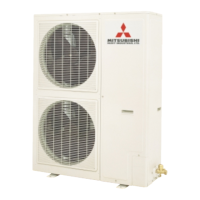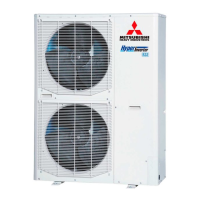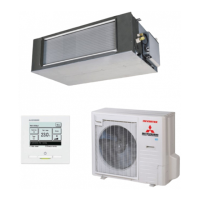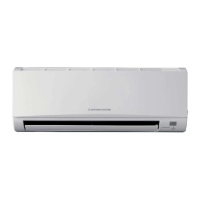●
A signal cable system is operated at DC5V, so never connect it to the power source 220/240V or 380/415V. If the power source is applied, a protective fuse
provided on the board will be actuated. If the protective fuse is actuated, follow the procedure set out below.
(1) Turn off power and make sure that 220/240V or 380/415V is not applied to signaling wires.
(2) In the case of an indoor unit, switch from CNK1 to CNK2 and cut the jumper line JSL1.
(3) In the case of an outdoor unit, switch from CNX1 to CNX2 and cut the jumper line J10.
(4) Check signal cable terminal block resistance before you turn on power. If the resistance value is 100 ohms or less, there is possibility that a power cable is connected to a
signal cable terminal block.
A typical resistance value is [46000 / (No. of connected FD○A△△KXE4 and KXE5 series units x 5) + (No. of connected FD○△△KXE6 and KXZ series units x 9)].
If the resistance value is 100 ohms or less, tentatively detach signal cables and thus, divide the network into more than one block (to reduce the number
of indoor units connected in a network) to check for cabling errors in each such block.
Signal line (mm
2
)
20A, 30mA
less than 0.1 sec
2
3.5
5.5
5.5
30A, 30mA
less than 0.1 sec
40A, 30mA
less than 0.1 sec
8
90KXZEN1-W
112KXZEN1-W
121KXZEN1-W
140KXZEN1-W
155KXZEN1-W
112KXZES1-W
121KXZES1-W
140KXZES1-W
155KXZES1-W
Single-phase
220/240V 50Hz
220V 60Hz
Three-phase
380/415V 50Hz
380V 60Hz
32 40 50 2 M4
20A, 30mA
less than 0.1 sec
3.5 46 20 30 2 M4
4−4. Additional refrigerant charge
Refrigerant pipe size
Additional charge volume (kg)
φ9.52
0.050
φ6.35
0.020
90, 112, 121, 140, 155 3.2
4.2
0.050 (Liquid piping φ9.52)
20
0
Cap tightening torque
(N・m)
Cap nut tightening torque
of check joint
(N・m)
φ9.52 (3/8") 34−42 20−30 13
φ15.88(5/8") 68−95 30−35 13
Fix both liquid and gas service valves at the valve main bodies as illustrated on the right,
and then fasten them, applying appropriate fastening torque.
Tightening angle
(° )
Tightening torque
(N-m)
φ6.35 (1/4")
φ9.52 (3/8")
φ12.7 (1/2")
φ15.88(5/8")
14−18
34−42
49−61
68−82
45−60
30−45
30−45
15−20
150
200
250
300
Use a torque wrench. If a torque wrench is not available,
fasten the flare nut manually first and then tighten it
further, using the left table as a guide.
Recommended length
of a tool handle (mm)
Service valve size
(mm)
Do not hold the valve cap area with a spanner.
●
Do not apply any oil on a flare joint.
●
Blazing must be performed under a nitrogen gas flow. Without nitrogen gas, a large quantity of foreign matters (oxidized film) are created, causing a critical failure
from capillary tube or expansion valve clogging.
●
Brazing of the service valve and the pipes should be performed while cooling the valve body with a wet towel.
●
Perform flushing. To flush the piping, charge nitrogen gas at about 0.02MPa with a pipe end closed with a hand. When pressure inside builds up to a sufficient
level, remove the hand to flush. (in flushing a pipe, close the other end of the pipe with a plug).
Plug the end of the pipe with tape, or other
material, and fill the pipe with nitrogen gas.
Only use nitrogen gas (N
2
)
Taping
<N
2
>
Nitrogen
Brazing
Brazing
Flatten
Adhesive tape
Station valve
Primary side Secondary side
0.02MPa
Hand
Relief valve
Nitrogen
gas
Operation procedure
①
During the pipe installation at site, keep the service valves shut all the time.
②
Blazing must be performed under a nitrogen gas flow. Without nitrogen gas, a large
quantity of foreign matters (oxidized film) are created, causing a critical failure from
capillary tube or expansion valve clogging.
③
Give sufficient protections (compressed and brazed or with an adhesive
tape) so that water or foreign matters may not enter the piping.
④
Perform flushing. To flush the piping, charge nitrogen gas at about 0.02MPa with a pipe
end closed with a hand. When pressure inside builds up to a sufficient level, remove the
hand to flush. (in flushing a pipe, close the other end of the pipe with a plug).
Nitrogen
gas
①
Although an outdoor unit itself has been tested for air tightness at the factory, please check the connected pipes and indoor units for air tightness from the check
joint of the service valve on the outdoor unit side. While conducting a test, keep the service valve shut all the time.
②
Since refrigerant piping is pressurized to the design pressure of a unit with nitrogen gas for testing air tightness, please connect instruments according the drawing below.
Under no circumstances should chlorine-based refrigerant, oxygen or any other combustible gas be used to pressurize a system
Keep the service valve shut all the time. Do not open it under any circumstances.
Be sure to pressurize all of the liquid, gas pipes.
③
In pressurizing the piping, do not apply the specified level of pressure all at once, but gradually raise pressure.
a) Raise the pressure to 0.5 MPa, and then stop. Leave it for five minutes or more to see if the pressure drops.
b) Then raise the pressure to 1.5 MPa, and stop. Leave it for five more minutes to see if the pressure drops.
c) Then raise the pressure to the specified level (4.15 MPa), and record the ambient temperature and the pressure.
d) If no pressure drop is observed with an installation pressurized to the specified level and left for about one day, it is acceptable. When the ambient temperature
changes 1℃, the pressure also changes approximately 0.01 MPa. The pressure, if changed, should be compensated for.
e) If a pressure drop is observed in checking e) and a) – d), a leak exists somewhere. Find a leak by applying bubble test liquid to welded parts and flare joints and
repair it. After repair, conduct an air-tightness test again.
④
Always pull air from the pipes after the airtightness test.
To indoor unit
Gauge manifold
Lo
Lo knob
Hi
Hi knob
Service point
(check joint)
Service valve
Liquid pipe
Gas pipe
Outdoor unit
CAUTION
Applying excessive pressure can cause an
inflow of nitrogen gas into an outdoor unit.
Air tightness test
<Work flow>
Fill refrigerant
Please run the vacuum pump for at least one hour
after the vacuum gauge shows -101kPa or lower.
(-755mmHg or lower)
Confirm that the vacuum gauge indicator does not
rise after leaving the system for an hour or more.
When the system has remaining
moisture inside or a leaky point,
the vacuum gauge indicator will
rise.
Check the system for a leaky
point and then draw air to create
a vacuum again.
CAUTION
Insufficient vacuuming may result in poor
performance falling short of the design
capacity, pipe clogging due to residue
moisture and/or a compressor failure.
Vacuuming
Please pull air from the check joints of the service valves on both liquid and gas sides.
Airtighteness test completed
Vacuuming begins
Vacuuming completed
Vacuum gauge check
Pay attention to the following points in addition to the above for the R32 and compatible machines.
○
To prevent a different oil from entering, please assign dedicated tools, etc. to each refrigerant type. Under no circumstances must a gauge manifold and a
charge hose in particular be shared with other refrigerant types (R22, R407C, R410A etc.).
○
Use a counterflow prevention adapter to prevent vacuum pump oil from entering the refrigerant system.
Hexagonal wrench
(M4)
Liquid/gas operation
Open
When a vacuum air purge is completed, remove the valve rod cap nuts and open the service valves
(both liquid and gas sides) as illustrated below. After you have made sure that the valves are in the
full-open position, tighten the cap nuts (for the valve rods and charge ports).
●
Open the valve rod until it touches the stopper.
You need not apply force to push it further.
Liquid service valve
(with a charge port)
Charge port
Gas service valve
Compound pressure gauge Pressure gauge
Gauge manifold
(for R32 only)
Handle Hi
Handle Lo
Charge hose (for R32 only)
Charge hose
(for R32 only)
Check valve
Vacuum adapter
(for R32 only)
Vacuum
pump
−101KPa(−755mmHg)
In-unit check joint
●
You can purge air with either liquid service valve or gas service valve.
Remove the hexagon cap nut, set it as illustrated
in the drawing below.
Factory setting (close)
Open
Pin type
▲
Hexagonal wrench type
▲
Stopper
Pin
For tightening torque, refer to the table below.
Tightening torque
(N-m)
Service valve size
(mm)
Additional refrigerant charge
Charge additional refrigerant in the liquid state.
Be sure to measure the quantity with a scale in adding refrigerant.
If you cannot charge all refrigerant with the outdoor unit lying idle, charge it with the unit running in the test run mode. (For the test run method, please refer to Section 8)
If operated for a long time with insufficient refrigerant the compressor will be damaged. (In particular, when adding refrigerant during operation, complete the job within 30min.)
Fill this unit only with the standard amount of refrigerant (piping length 0m fill quantity).
Determine the amount of refrigerant to be charged additionally using the following formula and put down the amount of refrigerant added on the refrigerant charge volume
recording plate provided on the back of the side panel.
●
Adding additional refrigerant
Charge additional refrigerant according to the size and length of the liquid piping.
Determine additional charge volume by rounding to the nearest 0.1 kg.
Additional fill quantity (kg)=P+I
P: Additional refrigerant quantity for piping (kg)
Pipe length for
baseline charge
volume (m)
Item
Capacity
Standard refrigerant
charge volume (kg)
Additional charge volume (kg)
per meter of refrigerant piping
(liquid pipe)
Refrigerant volume
charged for shipment
at the factory (kg)
Installation’s pipe length (m)
covered without additional
refrigerant charge
●
A standard refrigerant charge volume means a refrigerant charge volume for an installation with 0m long refrigerant piping.
●
This unit contains factory charged refrigerant covering 20m of refrigerant piping and additional refrigerant charge on the installation site is not required for
an installation with up to 20m refrigerant piping.
When refrigerant piping exceeds 20m, additionally charge an amount calculated from the pipe length and the above table for the portion in excess of 20m.
Refrigerant (necessary) charge volume for piping (kg) = Standard refrigerant charge 3.2kg + φ9.52 Total length of liquid pipes (m) x 0.050 (kg/m) +
φ6.35 Total length of liquid pipes (m) x 0.020 (kg/m)
P = Refrigerant (necessary) charge volume for piping (kg) - Factory charged volume 4.2 (kg)
Formula to calculate the volume of additional refrigerant required
Model 90, 112, 121, 140, 155
*When an additional charge volume calculation result is negative, it is not necessary to charge refrigerant additionally.
●
If the pipe length is shorter than 5 m, you should charge a reduced refrigerant volume.
Recover the refrigerant from the system and charge the standard refrigerant charge + the amount for liquid pipe.
Pay attention to the following points in addition to the above for the R32 and compatible machines.
●
To prevent a different oil from entering, please assign dedicated tools, etc. to each refrigerant type. Under no circumstances must a gauge manifold and a charge hose
in particular be shared with other refrigerant types (R22, R407C, R410A etc.).
●
Do not use a charge cylinder under any circumstances. There is a danger that the composition of the refrigerant will change when R32 is transferred to a cylinder.
●
When charging refrigerant, use liquid refrigerant from a cylinder.
●
Use a Adverse current prevention adapter so that vacuum pump oil does not mix in a system.
4-3. Air tightness test and air purge
(Carry them out according to the following steps.)
4-5. Heat insulation for prevention of dew condensation
(1) Dress refrigerant pipes (both gas and liquid pipes) for heat insulation and prevention of dew condensation.
Improper heat insulation/anti-dew dressing can result in a water leak or dripping causing damage to household effects, etc.
(2) Use a heat insulating material that can withstand 120℃ or a higher temperature. Poor heat insulating capacity can cause heat insulation problems or cable
deterioration.
●
All gas pipes must be securely heat insulated in order to prevent damage from dripping water that comes from the condensation formed on them during a cooling
operation or personal injury from burns because their surface can reach quite a high temperature due to discharged gas flowing inside during a heating operation.
●
Wrap indoor units’ flare joints with heat insulating parts (pipe cover) for heat insulation (both gas and liquid pipes).
●
Give heat insulation to both gas and liquid side pipes. Bundle a heat insulating material and a pipe tightly together so that no gaps may be left between them and
wrap them together with a connecting cable by a dressing tape.
●
Although it is verified in a test that this air conditioning unit shows satisfactory performance under JIS condensation test conditions, both gas and liquid pipes need
to be dressed with 10-20mm heat insulation materials additionally above the ceiling where relative humidity exceeds 70%.
Wires for connecting indoor
and outdoor units
Exterior tape
Gas piping
Insulation
Liquid piping
Band (accessory)
Pipe cover (accessory)
5. DRAINAGE
●
Where drain water from the outdoor unit causes problems, implement drain piping with drain elbows
and drain grommets.
●
There are 3 holes in the bottom panel of the outdoor unit to drain condensation.
●
Where condensate is guided to a drain, install the unit on a flat base (an option part supplied separately)
or concrete blocks.
●
Connect a drain elbow as illustrated and plug the other holes with grommets.
Drain elbow (1 piece)
Drain grommets
(2 pieces)
Hard general-purpose PVC pipe available on the market: VP16
6. ELECTRICAL WIRING WORK
Electrical installation work must be performed by an electrical installation service provider qualified by a power provider of the country.
Electrical installation work must be executed according to the technical standards and other regulations applicable to electrical installations in the country.
Please install a
n earth leakage breaker without fail. The installation of an earth leakage breaker is compulsory in order to prevent electric shocks or fire accidents.
(Since this unit employs inverter control, please use an impulse withstanding type to prevent an earth leakage breaker’s false actuation.)
Please note
a) Use only copper wires.
Do not use any supply cord lighter than one specified in parentheses for each type below.
- braided cord (code designation 60245 IEC 51), if allowed in the relevant part 2;
- ordinary tough rubber sheathed cord (code designation 60245 IEC 53);
- flat twin tinsel cord (code designation 60227 IEC 41)
- ordinary polyvinyl chloride sheathed cord (code designation 60227 IEC 53).
Please do not use anything lighter than polychloroprene sheathed flexible cord (cord designation 60245 IEC57) for supply cords of parts of appliances for outdoor use.
b) Use separate power supplies for the indoor and outdoor units.
c) The power supplies for indoor units in the same system should turn on and off simultaneously.
d
)
Ground the unit. Do not connect the grounding wire to a gas pipe, water pipe, lightning rod or telephone grounding wire.
A grounding wire must be connected before connecting the power cable. Provide a grounding wire longer than the power cable.
If improperly grounded, an electric shock or malfunction may result. Don’t connect the grounding wire to a gas pipe because it could cause explosion or ignition if gas leaks.
e)
The installation of an impulse with standing type earth leakage breaker is necessary. A failure to install an earth leakage breaker can result in an accident such as an
electric shock or a fire. Do not turn on the power until the electrical work is completed. Be sure to turn off the power when servicing.
f ) Please do not use a condensive capacitor for power factor improvement under any circumstances. (It does not improve power factor, while it can cause an abnormal overheat accident)
g) For power supply cables, use conduits.
h)
Please do not lay electronic control cables (remote control and signaling lines) and other high current cables together outside the unit. Laying them together can
result in malfunctioning or a failure of the unit due to electric noises.
i ) Power cables and signaling lines must always be connected to the terminal block and secured by cable fastening clamps provided in the unit.
j ) Fasten cables so that they may not touch the piping, etc.
k) When cables are connected, please make sure that all electrical components within the electrical component box are not free or not loose on the terminal
connection and then attach the cover securely. (Improper cover attachment can result in malfunctioning or a failure of the unit, if water penetrates into the box.)
l) Make sure to use circuit breakers (earth leakage breaker and circuit breaker) of proper capacity. Use of breakers of larger capacity could result in trouble on
components or fire accident. The circuit breaker should isolate all poles under over current.
m
) Install isolator or disconnect switch on the power supply wiring in accordance with the local codes and regulations. The isolator should be locked in OFF state in
accordance with EN60204-1.
n) After maintenance, all wiring, wiring ties and the like, should be returned to their original state and wiring route, and the necessary clearance from all metal parts
should be secured.
Wiring system diagrams
Signal line (between outdoor and indoor units <Ⅰ>)
〈 〉
Power source (Outdoor unit side) Outdoor unit
Single-phase
220/240V 50Hz
220V 60Hz
Three-phase
380/415V 50Hz
380V 60Hz
Single-phase
220/240V 50Hz
220V 60Hz
Power source (Indoor unit side)
grounding wire
grounding wire
Earth leakage breaker
Circuit breaker for cabling
(The example of combination)
Indoor unit
Remote control wire
〈 〉
X・Y X・Y
X・Y X・Y
A・B A・B
L
・
N
L
・
N
A・B
Signal line (for indoor units)
Remote
control
〈 〉
X・Y
X・Y
A・B
L
・
N
Earth
leakage
breaker
Circuit
breaker
for cabling
・・・
・・・
・・・
・・・
L・N
or
L1・L2・L3・N
CAUTION
If the earth leakage breaker is
exclusively for ground fault protection,
then you will need to install a circuit
breaker for wiring work.
Round crimp
contact terminal
Crimp
contact terminal
Diameter of a cable:thin
Diameter of a cable:thick
Wire
(1) Method of leading out cables
●
As shown on the drawing in Section 4-2, cables can be laid through the front, right, left or bottom casing.
●
In wiring on the installation site, cut off a half-blank covering a penetration of the casing with nippers.
●
In the case of an installation using a collective drain system, use a port other than the bottom one to take out cables and pipes.
If the bottom port is used, seal it thoroughly so that drain water may not spill out.
(2) Notabilia in connecting power cables
●
Connect the ground wire before you connect the power cable. When you connect a grounding wire to a terminal
block, use a grounding wire longer than the power cable so that it may not be subject to tension.
●
Do not turn on power until installation work is completed. Turn off power to the unit before you service the unit.
●
Always connect power cables to the power terminal block.
●
To connect a cable to the power terminal block, use a round crimp contact terminal.
If two cables are to be connected to one terminal, arrange cables in such a manner that you put their crimp
contact terminals together back to back. Further, put the thinner cable above the thicker one in arranging cables
for such connection.
●
Use specified wires in wiring, and fasten them securely in such a manner that the terminal blocks are not
subject to external force.
●
In fastening a screw of a terminal block, use a correct-size driver.
Fastening a screw of a terminal block with excessive force can break the screw.
●
When electrical installation work is completed, make sure that all electrical components within the electrical
component box are free of loose connector coupling or terminal connection.
Method of connecting power cables
Model
Power source
Cable size for
power source (mm
2
)
Wire length
(m)
Rated current
Switch capacity
Size (mm
2
)
Screw type
Moulded-case circuit breaker (A)
Earth wire
Earth leakage breaker
21
20
30
2 cores ×0.75
※
33
24
30
Rated current
Switch capacity
Moulded-case circuit breaker (A)
Earth leakage breaker
outdoor-indoor
indoor-indoor
Combined total capacity
of indoor units
Cable size for
power source(
mm
2
)
Wire length(m)
Please note
a) The method of laying cables has been determined pursuant to the Japanese indoor wiring regulations (JEAC8001). (Please adapt it to the regulations in
effect in each country)
b) Wire length in the table above is the value for when the indoor unit is connect to the power cable in series also the wire size and minimum length when the
power drop is less than 2% are shown. If the current exceeds the value in the table above, change the wire size according to the indoor wiring regulations.
(Please adapt it to the regulations in effect in each country)
c) For details, please refer to the installation manual supplied with the indoor unit.
The communication protocol can be choosen from following two types. One of them is the conventional Superlink (hereinafter previous SL) and the other is the new
SuperlinkⅡ (hereinafter new SL) . These two communication protocols have the following advantages and restrictions, so please choose a desirable one meeting your
installation conditions such as connected indoor units and centralized controller. When signal cables are connected into a network involving outdoor units, indoor units or
centralized control equipment that do not support new SL, please select communications in the previous SL mode, even if the refrigerant system is separated from theirs.
How to connect signal cables
Outdoor unit setting (SW5-5)
No. of connectable indoor units in a network
No. of connectable outdoor unitsin a network
Signal cable (total length)
Signal cable (furthest length)
Connectable units to a network
ON
Max. 48
Max. 48
Up to 1000m
Up to 1000m
Units not supporting new SL (FD
○
A
△△
KXE4series)
Units supporting new SL (FD
○△△
KXE6series)
Can be used together. (*1)
OFF (factory setting)
Max. 128
Max. 32
Up to 1500m (When 0.75mm
2
shielded cable used)
Up to 1000m (When 1.25mm
2
shielded cable used)
Up to 1000m
Power source specifications
Terminal block
less than 7A
less than 11A
less than 12A
less than 16A
Units supporting new SL (FD○△△KXE6KXZseries)
※Please use a shielded cable.
Conventional communication protocol (previous SL)Communication protocol
New communication protocol (new SL)
・When an operation is completed, replace the cap nut and tighten it as before.
・Shaft operation, cap and cap nut is performed by excessive torque, it will become failure
and a cause of a leak, please follow a table.
※1 New SL supporting units and non-supporting units cannot be used together in a same refrigerant system.
(1) Outdoor unit power source (Indoor unit is another power source.)
(2) Indoor unit power source (Outdoor unit is another power source.) & signal line
I: Additional refrigerant quantity for indoor units (kg)
If the total indoor units capacity is larger than outdoor unit capacity, then calculate the additional refrigerant quantity for indoor units.
D = {(Total indoor units capacity) - (outdoor unit capacity)}
I = D x 0.005
When D > 0, calculate I using the above equation;
When D
≦
0, take it as I = 0.
<Example>
When you connect FDC140 to FDT45 x 4 units:
D= 45 x 4 - 140= 40 (> 0)
I= 40 x 0.005 = 0.2 (kg)
-
16
-
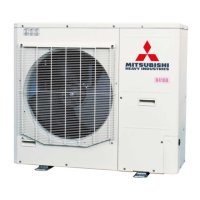
